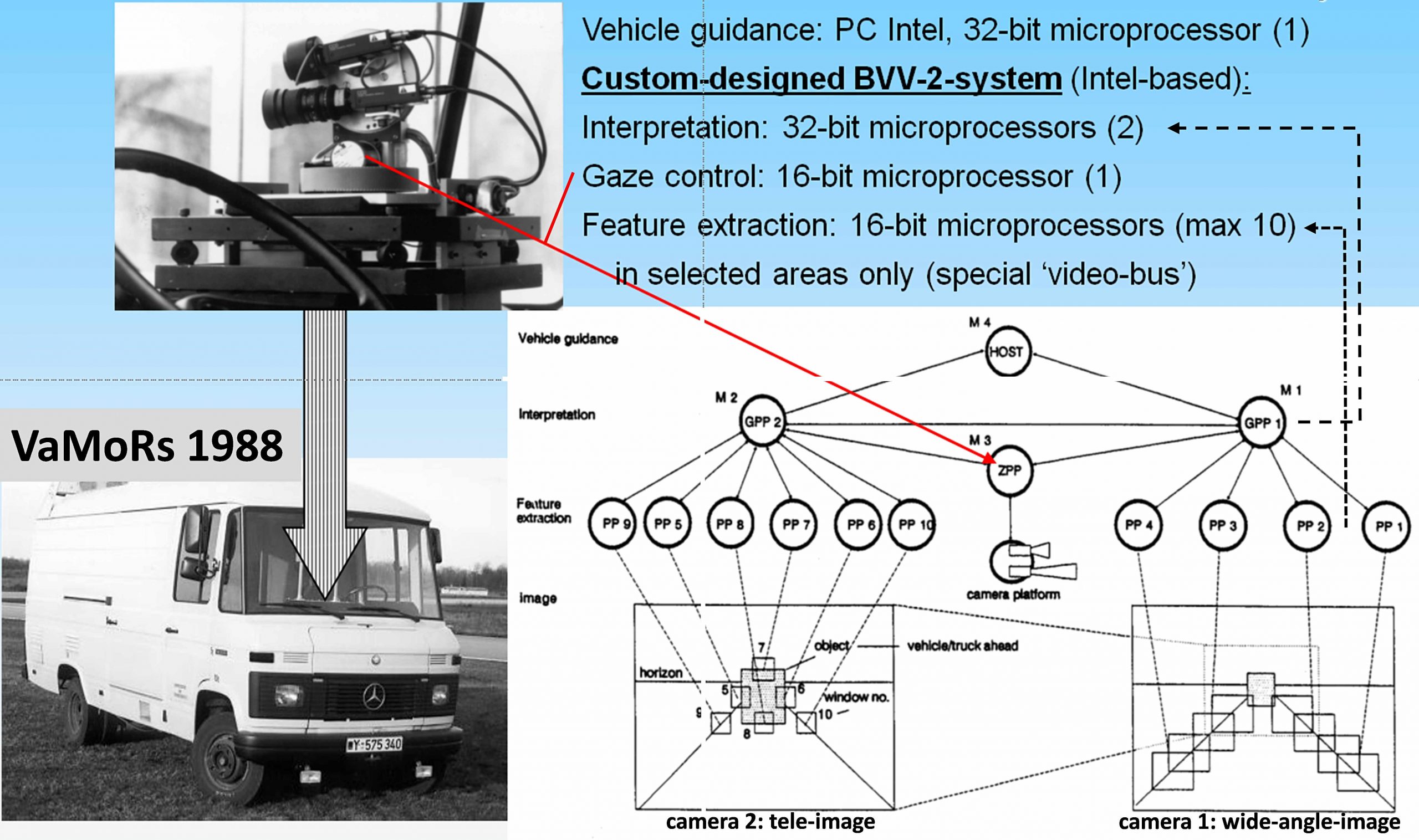Standard industrial microprocessors in custom designed system architecture (1st − generation):
The concept was to grab video signals in small ‘windows’ (32 x 32 pixels) from those parts of the image sequence only, where interesting features of the objects to be found could be expected. Of course, this required predictions for the motion process observed, including the measurement models for perspective mapping.
With increasing computing power per processor (an order of magnitude every 4 to 5 years) and experience in real-time vision according to the “4-D approach”, two generations of BVV-systems have been used by our group:
- The BVV1 with 8-bit processors Intel 8085 for
- A.1 Pole balancing (hier Link zu diesem Abschnitt einbauen)
Video 1984 Pole Balancing with Perturbations.mp4 (Größe ~ 3,4 MB) and - A.2 Satellite model plant (hier Link zu diesem Abschnitt einbauen)
Video 1987 Satellite Docking air cushion veh.mp4 (Größe ~ 19,25 MB)
- A.1 Pole balancing (hier Link zu diesem Abschnitt einbauen)
- The BVV2 with 16- to 32-bit processors Intel 80×86 for road- and air vehicle guidance; this one is sketched below.
With increasing computer power, the number of features extractable per window increased, so that the number of parameters to be estimated for modeling the road as well as for detecting features of several objects to be perceived in parallel, could also be increased. The basic structure of the architecture remained the same: Low-level feature extraction (bottom, guided by feedback from higher levels), feature interpretation and tracking of n objects in parallel (on the medium level), and interpretation of the situation as well as derivation of the control output on the (uppermost) host level.
Direct correspondence between subtasks and hardware components,
- Two sets of parallel processors (PP, Intel 8086 16-bit) grabbed the pixels in dynamically locatable windows of size 32 x 32 pixels [Graefe 1984];
- windows were placed with the center at the position where edge features had been found last time.
- Two 16 – (32-) bit general purpose processors (GPP) for object state estimation by prediction error feedback.
- They sent their results to the host and to gaze control (ZPP):
- The host-PC was used as human interface and for deriving and initiating the control output which was implemented by special microprocessors near the actuators (not shown).
- a microprocessor for controlling gaze direction of the two-axis pointing platform (ZPP).
References
Meissner HG (1982). Steuerung dynamischer Systeme aufgrund bildhafter Informationen. Dissertation, UniBwM / LRT. Kurzfassung
Dickmanns ED, Zapp A, Otto KD (1984). Ein Simulationskreis zur Entwicklung einer automatischen Fahrzeugführung mit bildhaften und inertialen Signalen. In Breitenecker, et al. (ed): Simulationstechnik, Informatik-Fachberichte 85, Springer, pp 554-558
Graefe V (1984): Two Multi-Processor Systems for Low Level Real-Time Vision. In: Brady JM, Gerhard LA, Davidson HF (eds) (1984). Robotics and Artificial Intelligence. Springer–Verlag: 301–307
Dickmanns ED, Zapp A (1985). Guiding Land Vehicles Along Roadways by Computer Vision. Proc. Congres Automatique 1985, AFCET, Toulouse, pp 233-244
Dickmanns ED, Graefe V (1988). (a) Dynamic monocular machine vision. Journal of Machine Vision and Application, Springer International 1:223-240. (b) Applications of dynamic monocular machine vision. (ibid): 241–261. Excerpts pdf
Zapp A (1988). Automatische Straßenfahrzeugführung durch Rechnersehen, Dissertation, UniBwM / LRT. Kurzfassung
Mysliwetz B (1990). Parallelrechner-basierte Bildfolgen-Interpretation zur autonomen Fahrzeugsteuerung. Diss., UniBwM / LRT. Kurzfassung
